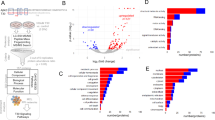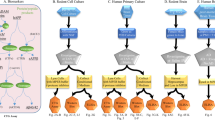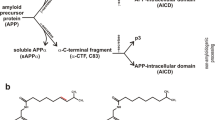Abstract
We have investigated the acute and chronic effect of metrifonate (MTF) and dichlorvos (DDVP), respectively the prodrug and active acetylcholinesterase inhibitor, on the secretory processing of the amyloid precursor protein (APP) in SH-SY5Y neuroblastoma cells. We demonstrate that the acute treatment of SH-SY5Y cells with both compounds results in an increased secretion of the soluble fragment of APP (sAPPα) into the conditioned media of cells, with a pattern correlated to the level of acetycholinesterase inhibition. The regulation of APP processing in these conditions is mediated by an indirect cholinergic effect on muscarinic receptors, as demonstrated by inhibition with atropine. We have also followed APP expression and metabolism after long-term treatment with metrifonate. Treated cells showed reduced AChE activity after 24, 48?h and also following 7 days of repeated treatment, a time point at which increased AChE expression was detectable. At all time points sAPPα release was unaffected suggesting that enhanced sAPPα release by MTF is transitory, nevertheless the sensitivity of cholinergic receptors was unchanged, as indicated by the fact that cholinergic response can be elicited similarly in untreated and treated cells. APP gene expression was unaffected by long-term AChE inhibition suggesting that increased short-term sAPPα release does not elicit compensatory effects.
This is a preview of subscription content, access via your institution
Access options
Subscribe to this journal
Receive 12 print issues and online access
$259.00 per year
only $21.58 per issue
Buy this article
- Purchase on Springer Link
- Instant access to full article PDF
Prices may be subject to local taxes which are calculated during checkout






Similar content being viewed by others
References
Selkoe DJ . Amyloid beta-protein and the genetics of Alzheimer's disease J Biol Chem 1996 271: 18295–18298
Tanzi RE, McClatchey AI, Lamperti ED, Villa-Komaroff L, Gusella JF, Neve RL . Protease inhibitor domain encoding by an amyloid protein precursor mRNA associated with Alzheimer disease Nature 1988 331: 115–126
Kang J, Lemaire HG, Unterbeck A, Salbaum JM, Masters CL, Greschik KH et al. The precursor of Alzheimer's disease amyloid A4 protein resembles a cell surface receptor Nature 1987 325: 733–736
Racchi M, Govoni S . Rationalizing a pharmacological intervention on the amyloid precursor protein metabolism TIPS 1999 20: 418–423
Esch FS, Keim PS, Beattie EC, Blacher RW, Culwell AR, Oltersdorf T et al. Cleavage of amyloid β-peptide during constitutive processing of its precursor Science 1990 248: 1122–1124
Anderson JP, Esch FS, Keim PS, Sambamurti K, Lieberburg I, Robakis NK . Exact cleavage site of Alzheimer precursor protein in neuronal PC 12 cells Neurosci Lett 1991 128: 126–128
Nitsch RM, Slack BE, Wurtman RJ, Growdon JH . Release of Alzheimer amyloid precursor derivatives stimulated by activation of muscarinic acetylcholine receptors Science 1992 258: 304–307
Hung AY, Haass C, Nitsch RM, Qiu WQ, Citron M, Wurtman RJ et al. Activation of protein kinase C inhibits cellular production of the amyloid beta-protein J Biol Chem 1993 268: 22959–22962
Buxbaum JD, Koo EH, Greengard P . Protein phosphorylation inhibits production of Alzheimer amyloid βA4 peptide Proc Natl Acad Sci USA 1993 89: 3050–3059
Wolf BA, Wertkin AM, Jolly YC, Yasuda RP, Wolfe BB, Konrad RJ et al. Muscarinic regulation of Alzheimer's disease amyloid precursor protein secretion and amyloid β-protein production in human neuronal NT2N cells J Biol Chem 1995 270: 4916–4922
Mori F, Lai CC, Fusi F, Giacobini E . Cholinesterase inhibitors increase secretion of APPs in rat brain cortex Neuroreport 1995 6: 633–636
Giacobini E . Cholinesterase inhibitors do more than inhibit cholinesterase. In: Becker R, Giacobini E (eds). Alzheimer's Disease: From Molecular Biology to Therapy Birkhauser: Boston 1996 pp?187–204
Lahiri DK, Lewis S, Farlow MR . Tacrine alters the secretion of the beta-amyloid precursor protein in cell lines J Neurosci Res 1994 37: 777–787
Hinz VC, Grewing S, Scmitdt BH . Metrifonate induces cholinesterase inhibition exclusively via slow release of dichlorvos Neurochem Res 1996 21: 331–337
Bergamaschi S, Binetti G, Govoni S, Wetsel WC, Battaini F, Trabucchi M et al. Defective phorbol ester-stimulated secretion of beta-amyloid precursor protein from Alzheimer's disease fibroblasts Neurosci Lett 1995 201: 1–5
Ellman GI, Courtney KD, Andres VJ, Featherstone RM . A new, rapid colorimetric determination of acetylcholinesterase activity Biochem Pharmacol 1961 7: 88–95
Ehrich M . Using neuroblastoma cell lines to address differential specificity to organophosphates Clin Exp Pharmacol Physiol 1995 22: 291–292
Weidemann A, Konig G, Bunke D, Fischer P, Salbaum JM, Masters CL et al. Identification, biogenesis, and localization of precursors of Alzheimer's disease A4 amyloid protein Cell 1989 57: 115–126
Ganter U, Strauss S, Jonas U, Weidemann A, Beyreuther K, Volk B et al. Alpha 2-macroglobulin synthesis in interleukin 6 stimulated human neuronal (SH-SY5Y neuroblastoma) cells. Potential significance for the processing of Alzheimer beta amyloid precursor protein FEBS Lett 1991 282: 127–131
Knopman DS, Morris JC . An update on primary drug therapies for Alzheimer disease Arch Neurol 1997 54: 1406–1409
Benzi G, Moretti A . Is there a rationale for the use of acetylcholinesterase inhibitors in the therapy of Alzheimer's disease? Eur J Pharmacol 1998 346: 1–13
Farber SA, Nitsch RM, Schulz JG, Wurtman RJ . Regulated secretion of β-amyloid precursor protein in rat brain J Neurosci 1995 15: 7442–7451
Morris JC, Cyrus PA, Orazem J, Mas J, Bieber F, Ruzicka BB et al. Metrifonate benefits cognitive, behavioural, and global function in patients with Alzheimer's disease Neurology 1998 50: 1222–1230
Schmidt BH, Roland Heinig R . The pharmacological basis for metrifonate's favourable tolerability in the treatment of Alzheimer's disease Dementia and Geriatric Cognitive Disorders 1998 9 (Suppl 2): 15–19
Pakaski M, Rakonczay Z, Fakla I, Papp H, Kasa P . In vitro effects of metrifonate on neuronal amyloid precursor protein processing and protein kinase C level Brain Res 2000 863: 266–270
Slack BE, Breu J, Petryniak MA, Srivastava K, Wurtman RJ . Tyrosine phosphorylation-dependent stimulation of amyloid precursor protein secretion by the m3 muscarinic acetylcholine receptor J Biol Chem 1995 270: 8337–8344
Lahiri DK, Farlow MR, Sambamurti K . The secretion of amyloid beta-peptides is inhibited in the tacrine-treated human neuroblastoma cells Brain Res Mol Brain Res 1998 62: 131–140
Salvietti N, Cattaneo E, Govoni S, Racchi M . Changes in beta amyloid precursor protein secretion associated with the proliferative status of CNS derived progenitor cells Neurosci Lett 1996 212: 199–203
Racchi M, Johnston JA, Flood FM, Cowbum RF, Govoni S . Amyloid precursor protein metabolism in fibroblasts from individuals with one, two or three copies of the amyloid precursor protein (APP) gene Biochem J 1999 338: 777–782
Acknowledgements
This research was partially funded by MURST Cofin99, ‘Fondo Ateneo Ricerca’ and ‘Progetto Ateneo’ University of Pavia, Telethon E866 to SG.
Author information
Authors and Affiliations
Corresponding author
Rights and permissions
About this article
Cite this article
Racchi, M., Sironi, M., Caprera, A. et al. Short- and long-term effect of acetylcholinesterase inhibition on the expression and metabolism of the amyloid precursor protein. Mol Psychiatry 6, 520–528 (2001). https://doi.org/10.1038/sj.mp.4000878
Received:
Revised:
Accepted:
Published:
Issue Date:
DOI: https://doi.org/10.1038/sj.mp.4000878
Keywords
This article is cited by
-
PMS777, a New Cholinesterase Inhibitor with Anti-Platelet Activated Factor Activity, Regulates Amyloid Precursor Protein Processing In Vitro
Neurochemical Research (2009)
-
Acetylcholine receptors in dementia and mild cognitive impairment
European Journal of Nuclear Medicine and Molecular Imaging (2008)
-
Role of acetylcholinesterase inhibitors in pharmacological regulation of amyloid precursor protein processing
Aging Clinical and Experimental Research (2006)
-
The significance of the cholinergic system in the brain during aging and in Alzheimer’s disease
Journal of Neural Transmission (2006)
-
Implications of co-morbidity for etiology and treatment of neurodegenerative diseases with multifunctional neuroprotective-neurorescue drugs; ladostigil
Neurotoxicity Research (2006)



